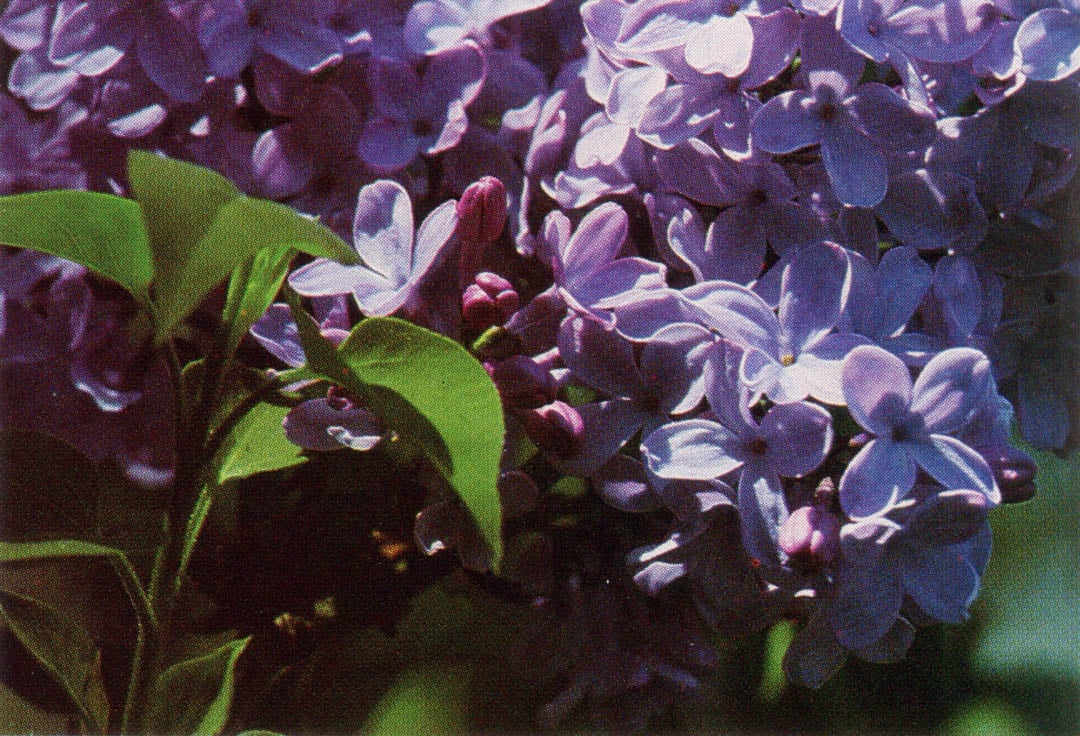

Contributor
- Topics: Archive, Plants You Need

Any lilac is ‘easy’: they do not object to lime, in fact they like it; they need no pruning, though it is most advantageous to cut off the faded flowers, this is really important; they are perfectly hardy; and very long-lived unless they suddenly die back, which sometimes happens. Of course they repay rich cultivation; most plants do. And they like the sun.
Vita Sackville-West
In spring the fragrance emanating from the lilac grove at Descanso Gardens in Los Angeles delights visitors to the garden, who expect to see lilacs blooming only in cold climates.
About twenty different lilacs, twelve of which are available commercially, bloom from late March to late April. Most of these are products of hybridization by Dr Walter Lammerts, renowned horticulturist who worked there when Manchester Buddy owned Rancho del Descanso.
In 1942, when Dr Lammerts was employed at the University of California, Los Angeles, he visited W.B. Clark, owner at that time of Clark Nurseries in San Jose. Dr Lammerts obtained seeds of some lilacs that Mr Clark had found would bloom without winter chill, including ‘Lamartine’, ‘Buffon’, ‘Vestale’, ‘Kate Sessions’, ‘Claude Bernard’, and an unnamed variety designated C112.

Dr Lammerts planted the seeds at UCLA, where they developed into seedlings. In 1945 he joined Manchester Boddy at Descanso. In spring 1950, when most of the lilacs were in bloom, he selected the best and budded them onto privet plants, which he set out at Descanso. Those he subsequently hybridized inherited the characteristic of early leafing without chill and were sufficiently good bloomers for commercial introduction. One of the best known of these is ‘Lavender Lady’. The other four are ‘Old Lace’, ‘Heather Haze’, ‘Big Blue’, and ‘Sweet Charity’. These were distributed by arrangement with Hines Nursery in Santa Ana for several years in the late 1970s. ‘Lavender Lady’ is still offered by Monrovia Nursery and by Gerd Schneider, a wholesale grower near Watsonville.

Other lilacs that originated at Descanso, perhaps grown from seeds of plants raised by Dr Lammerts, include ‘California Rose’, ‘Chiffon’, ‘Dark Knight’, ‘David Gilfillian’, ‘Descanso Giant’, ‘Little Pinkie’, ‘Mrs Forrest Kresser Smith’, ‘Pride of the Guild; ‘Sylvan Beauty’, and ‘White Spring’. Many of these are available through nurseries in the Los Angeles area.
To ensure good blooms, old flower spikes should be removed immediately after flowering in spring. If they are allowed to go to seed the flowering crop will be reduced the following season. After Labor Day, do not water the lilacs at all until the first feeding around the beginning of February. Withholding water forces the plants into a state of dormancy, ensuring a good flowering crop next season.
Because of the need to restrict water, it is best to avoid planting lilacs near lawns or in any other area that receives regular irrigation. Lilacs require alkaline soil and benefit from an application of agricultural lime broadcast each fall. This intensifies the color of the flowers. Lilacs also thrive with applications of barnyard manure or packaged nitrohumus applied four inches thick around each shrub. Fertilize three times a year, beginning in February at the onset of watering and then twice more at five-week intervals. A 5-3-1 formula is suitable.
Using these methods the varieties mentioned can be grown successfully in southern California gardens.
Share:
Social Media
Garden Futurist Podcast
Most Popular
Videos
Topics
Related Posts

Low Maintenance Gardens – Better for Pollinators and People
Autumn 2022 “I come out every day. It’s therapy, my meditation.” Janet’s young garden transformed from overgrown, invasive plants to mostly natives. The dailiness of

Calochortophilia: A Californian’s Love Affair with a Genus
Summer 2022 I can chart the progression of my life by Calochortus. For the last two decades, at least. As a teenage girl growing up

Pacific Plant People: Carol Bornstein
Spring 2022 Public gardens play a key role in demonstrating naturalistic planting design, selecting native and adapted plants for habitat, and testing techniques for reducing

Add Year-Round Interest and Winter Blooms for Pollinators
Spring 2022 This article was created from an Interview by Merrill Jensen with Neil Bell in the Summer of 2021 for our Pacific Plant People








Responses